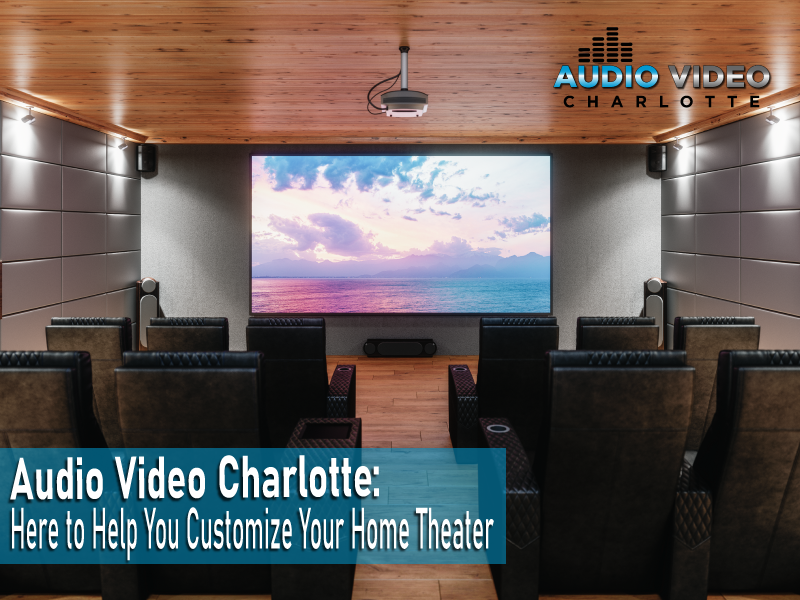By doing home renovations for your media theater, it gives you the opportunity to hide your wires and plan the placement of your media products. You can create hidden cabinets and custom shelves to personalize your own space, and Audio Video Charlotte is your go-to for all things home theater renovations.
First, let’s unpack the idea of “renovation.” You don’t have to put your house up on blocks, gutting it from the inside out, for it to be considered a renovation/remodeling project. The good part about renovating your home media theater, whether you are doing it yourself or having it hired out, is the opportunity to hide wires and create better sound—even on a small budget.
Remodeling your media theater can increase the value of your home, but most importantly, it will definitely increase your enjoyment factor whether this space is designed for only a few or the entire family.
At Audio Video Charlotte we can help plan, create, and customize any space in your home. Working with our customers, we have found that doing a media theater renovation doesn’t have to be stressful. With proper planning and the right help where you need it, your project can actually be…dare I say it…fun.
A few things we have learned along the way:
Take note of the space you have to work with. Is it large or small? Do you have low ceilings, or are they high and create and echo? Think about where you want to sit when you watch television or listen to music. Take a turn around the room sitting in different spots, getting a feel for what should go where.
If you want to get more specific about the aesthetic, consider lighting and soundproofing. This space is meant to be a hideaway, separate from the rest of the house, and you don’t want these two worlds colliding. Put a speaker in the wrong spot and you could end up with someone pounding on the wall telling you to “TURN IT DOWN!”
Whether you plan to use natural light or create your own, you might want to first think about where you want your screens located within the room. The screen-lighting relationship can be a dicey one, but with the proper guidance your lighting can do a lot to create ambiance for your theater room.
The Basics on Your Media Products
Before planning your media setup, you should know some of the basic products and what they do. Here is a quick breakdown of the most common media devices found in a home theater:
In a media room, the audio system is created by a combination of an AV (audio-video) receiver, five speakers, and a subwoofer. These are the building blocks for any effective home theater setup. The receiver controls everything, and modern receivers can do a lot!
First, the provide power to the five speakers (the speaker wires connect directly into the receiver itself). And, like the speakers, the satellite or cable box, the gaming system, DVD player, etc. are also connected to the receiver and it works with you by selecting which system you want to use—see how important having a good receiver is.
Through the receiver you can also control the volume and adjust the balance of volume flowing between the five speakers. Here are a few other important things the receiver does:
- It sends a video signal to the television or monitor so you can control what you are watching.
- It processes all audio, including surround-sound and other effects—and it can perform video conversion.
This is the basic breakdown for how a home-media center works, but the key is getting yourself quality speakers and a trusted receiver. And Audio Video can help you with that.
Hiding Your Wire
If you plan on wiring your media center yourself, be sure to take your time and do your research. Once you have your plan of action, take some extra time to see how much wire you will need. (It’s a good idea to consult a professional with this, even if you still want to wire yourself. But seeking the help of a pro you can keep the cost down by not accidently buying too much wiring, plus your technician can help you map-out your wiring route to and from devices.
Here are a few basic wiring tips:
- Give yourself a little extra wire, just incase you make a wrong cut. For example, if you want to install wall speakers by yourself, give an extra two or three feet of extra wire.
- Give yourself ten- to fifteen-percent wiggle room in your budget. You probably won’t have to use it, but it’s there if you do. Sometimes cutting holes in the wall for speakers and wire can open up into something a little bigger, so be prepared.
- Most audio and video patch cables should not be used inside a wall. However, there are what’s called “baluns” that can be used in-wall that provide the same quality.
Larger projects can incorporate component racks and specialized wall plates and brackets. The key thing to keep in mind is you want your space clean and organized, so put in that extra work now so that you don’t forget where everything is located.
Hiding Your Speakers
To have a worth-while home theater means you must have quality audio. But, instead of hanging those big box speakers here and there, try and hiding smaller, more powerful speakers in spaces where they are more heard than seen.
Here are some common speakers used for media theaters:
- In-wall speakers. Installed inside the drywall, sitting flush with the rest of the wall, these can easily be put in if you are putting up new drywall. But even if you are using the wall space you currently have, they can still work—just a little more effort. Once they are in, and you add some wall paint, you won’t even notice they are there.
- In-ceiling speakers. These are even more hidden than wall speakers and they can fit right in with any design. The great part about these is that the sound comes at you from above, giving a much different feel.
- Cabinet speakers. Built-in cabinets can house your speakers and dress them up a little as well. And, if built innovatively, they can even enhance your sound quality.
With a lot of planning, research, and a little help from a professional, you can have the home theater system of your dreams.
Audio Video Shelving & Hidden Cabinets
Floating shelves are a great way to create holding spaces for speakers and other media devices, but be careful of sagging. Be sure to screw into studs and do your research on how much the shelf can hold. If you end up using anchors, make sure you get the right ones for your wall and know the weight they will need to hold—save yourself from the incredible frustration of finding you have a loose piece of furniture.
Quick tip: try and keep your shelves at least twelve inches apart from one another. This creates a strong aesthetic feel and adds to the overall comfort of the room.
Installing hidden spaces and cabinets is also a good idea for your theater room. Consider a mantel that opens up its frame to reveal several secret compartments. Or, think about using moving walls that roll from one side to another. Depending on the size and figuration of the room, having the availability to move one or a few small walls around can totally change the dynamic and open up space in certain areas.
When it comes down to it, your best and first option should be to have a professional from Audio Video Charlotte come in and brainstorm with you about what would work best for your situation. Call us today and set up an appointment to get your home media theater in shape!






